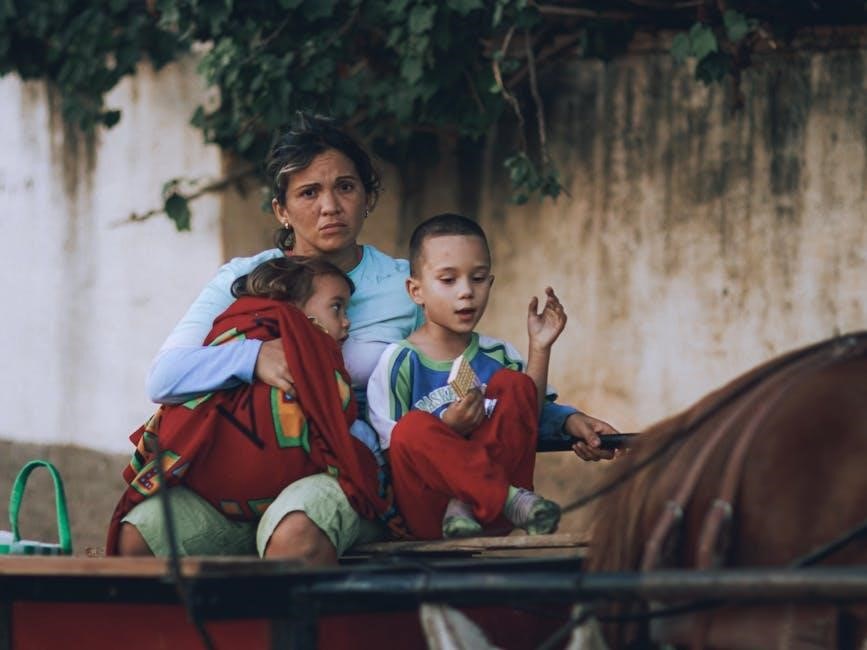Welcome to our comprehensive guide on horse blanketing! This essential practice helps maintain your horse’s body temperature, keeps them dry, and protects them from harsh weather conditions year-round․
Understanding the Importance of Horse Blanketing
Horse blanketing is crucial for maintaining your horse’s comfort and health․ It helps regulate body temperature, especially in extreme cold or wet conditions, and protects clipped or senior horses from harsh weather․ Blankets also prevent health issues related to cold stress and ensure your horse stays dry and warm, promoting overall well-being․ Proper blanketing practices are essential to avoid discomfort and potential health risks, ensuring your horse remains comfortable and healthy year-round․
Types of Horse Blankets
Horse blankets come in various styles, including turnout, stable, and sheets, each designed for specific weather conditions and purposes, ensuring comfort and protection for your horse․
Turnout Blankets
Turnout blankets are waterproof and designed for outdoor use, providing protection from rain and wind․ They are lightweight and breathable, making them ideal for colder months․ Available with or without fill, they keep horses warm and dry in pastures․ Durability is key, as they withstand harsh weather conditions while ensuring your horse stays comfortable and healthy․ Proper sizing is essential for optimal performance and comfort․
Stable Blankets
Stable blankets are designed for indoor use, providing warmth and comfort in colder environments․ They are typically made of thicker, non-waterproof materials and often have higher fill levels for added insulation․ These blankets are perfect for horses that spend most of their time in stalls․ They come in various weights, from lightweight to heavyweight, ensuring your horse stays cozy and warm during the winter months without the need for waterproofing․
Horse Sheets
Horse sheets are lightweight, versatile blankets designed for mild weather conditions․ They typically lack fill, making them ideal for spring and fall or as a base layer under heavier blankets․ Sheets are perfect for layering, offering protection without excess warmth․ They are breathable, durable, and easy to care for, making them a practical choice for everyday use or after exercise on cooler evenings․
Lightweight Blankets
Lightweight horse blankets are ideal for mild weather, offering minimal warmth and maximum breathability․ They are perfect for spring and fall, or for horses with lighter coats․ These blankets often feature a lower fill power, typically between 100 to 200 grams, and are designed to keep your horse comfortable without overheating․ They are a great option for horses that don’t need heavy insulation but still require some protection from cooler temperatures․
Mid-Weight Blankets
Mid-weight horse blankets are designed for cooler temperatures, offering a balance of warmth and breathability․ They typically have a fill power of 200 to 400 grams, making them suitable for fall and early winter․ These blankets are ideal for horses that need more insulation than lightweight options provide but don’t require the heavy warmth of winter blankets․ They often feature waterproof and breathable materials, ensuring comfort and protection in varied conditions․
Heavyweight Blankets
Heavyweight horse blankets are designed for extreme cold weather, providing maximum warmth and protection․ They typically have a fill power of 400 grams or higher, making them ideal for harsh winter conditions․ These durable blankets are constructed with robust materials to withstand heavy use and are often waterproof, ensuring your horse stays dry and comfortable even in freezing temperatures and snowy conditions․
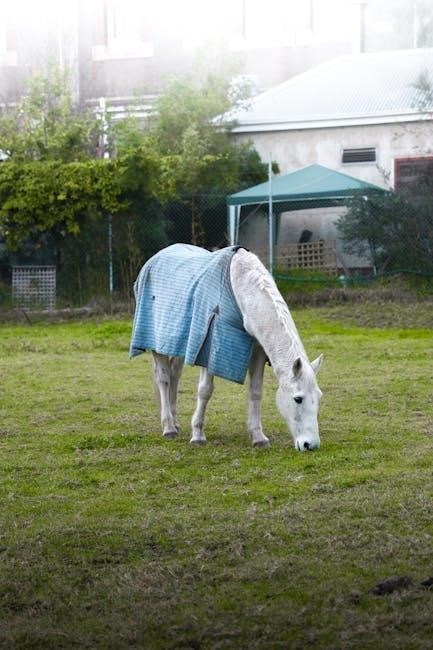
Factors to Consider When Choosing a Horse Blanket
When selecting a horse blanket, consider size, fit, denier rating, fill power, waterproofing, breathability, and fastening systems to ensure comfort and durability for your horse․
Size and Fit
Proper sizing is crucial for your horse’s comfort and mobility․ A well-fitting blanket prevents rubbing and ensures full range of motion․ Measure your horse accurately, considering length, girth, and neck size․ A too-small blanket can restrict movement, while an oversized one may shift or bunch up․ Always refer to the manufacturer’s size chart to ensure the best fit for your horse’s specific needs and body type․
Denier Rating
Denier rating measures the durability and thickness of a blanket’s fabric․ Higher denier ratings indicate stronger, more durable materials, ideal for outdoor use or harsh weather․ Lower denier fabrics are lighter and suitable for milder conditions․ Choosing the right denier ensures your horse stays protected without being overly restricted, balancing comfort and resilience based on their specific needs and environment․
Fill Power
Fill power refers to the insulating capacity of a horse blanket, measured by the amount of fill material inside․ Higher fill power means greater warmth, making it ideal for colder climates․ However, it’s important to balance fill power with your horse’s specific needs, as too much can overheat them․ Always consider temperature, humidity, and your horse’s activity level when selecting the right fill power for their blanket․
Waterproofing
Waterproofing is a crucial feature in horse blankets, especially for turnout use․ It protects your horse from rain and moisture, preventing chilling and discomfort․ Look for blankets with waterproof coatings or membranes, such as Gore-Tex, that allow breathability while keeping water out․ Proper fit and regular cleaning are essential to maintain the effectiveness of the waterproof layer and ensure your horse stays dry and warm in wet conditions․
Breathability
Breathability is key to preventing moisture buildup under your horse’s blanket, which can lead to discomfort and skin issues․ Look for materials that allow airflow and wick away sweat, ensuring your horse stays dry and comfortable․ Breathable blankets help regulate body temperature and prevent conditions like rain scald, making them essential for both indoor and outdoor use in varying weather conditions․
Fastening Systems
Fastening systems are crucial for ensuring your horse’s blanket stays securely in place․ Common options include adjustable buckles, Velcro straps, and elasticized surcingles․ A secure fit prevents shifting, rubbing, or the blanket coming undone․ Look for durable, easy-to-use fasteners that allow for a snug yet comfortable fit, ensuring your horse’s freedom of movement while keeping the blanket in position effectively․
Seasonal Blanketing Guidelines
Adjust your horse’s blanketing according to seasonal temperature changes and their individual needs․ Ensure proper layering and protection to maintain comfort and health throughout the year․
Spring
In the spring, temperatures are typically mild, so lightweight blankets or sheets are ideal for your horse․ Monitor their coat and adjust layering as needed․ Ensure breathability to prevent overheating during warmer days․ Spring is a transitional season, so be prepared to switch between lighter and mid-weight blankets based on weather fluctuations․ Always observe your horse’s comfort and adjust their blanketing accordingly to maintain optimal comfort and health․
Summer
During summer, horses typically require minimal blanketing due to warmer temperatures․ Lightweight sheets or fly veils can protect against sun and insects without causing overheating․ Avoid heavy blankets, as they can lead to discomfort and sweating․ Ensure your horse has access to shade and cool water․ Monitor temperature fluctuations, especially in regions with unpredictable weather, to determine if any light covering is necessary for comfort or protection․
Fall
Fall weather brings cooler temperatures, making it an ideal time to introduce lightweight or mid-weight blankets․ As days shorten and nights become chillier, horses may need extra warmth, especially if they’re clipped․ Monitor temperature drops and adjust blanketing accordingly․ Ensure blankets are breathable to prevent overheating during warmer daytime hours․ Regular grooming and proper fit are crucial to keep your horse comfortable throughout the season․
Winter
Winter blanketing is crucial for maintaining your horse’s comfort in cold weather․ Use heavyweight blankets with higher fill power (300g or more) for extreme conditions․ Ensure blankets are waterproof to protect against snow and ice․ Monitor your horse’s coat and adjust blanketing based on temperature fluctuations․ Senior or clipped horses may need extra warmth․ Regularly check for proper fit and adjust layers as needed to prevent overheating․
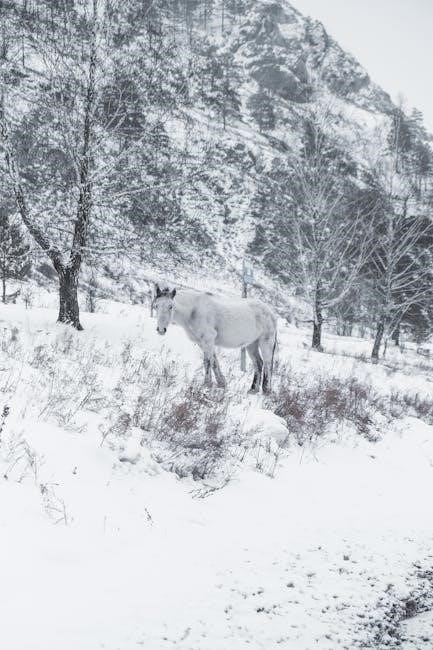
Ensuring Proper Fit and Sizing
Proper fit is essential for your horse’s comfort and safety․ Measure your horse from the center of the chest to the point of the rump to determine the correct size․ A well-fitting blanket should lie evenly, without shifting or rubbing, and allow full range of motion․ Adjust the blanket as needed to ensure it doesn’t restrict movement or cause discomfort․ Always check the fit after putting it on and monitor for signs of irritation or stress․
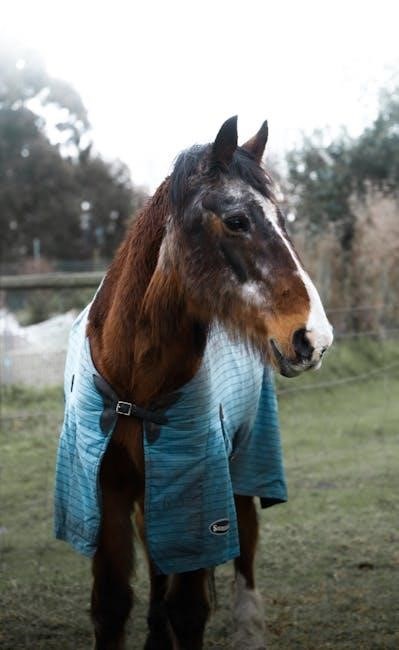
How to Care for Your Horse’s Blankets
Regularly clean and inspect your horse’s blankets to ensure they remain in good condition․ Spot clean stains and wash them seasonally․ Store blankets in a dry, clean area to prevent mildew․ Check for tears or worn-out areas and repair them promptly․ Proper care extends the life of the blanket and ensures your horse stays comfortable and protected throughout the year․
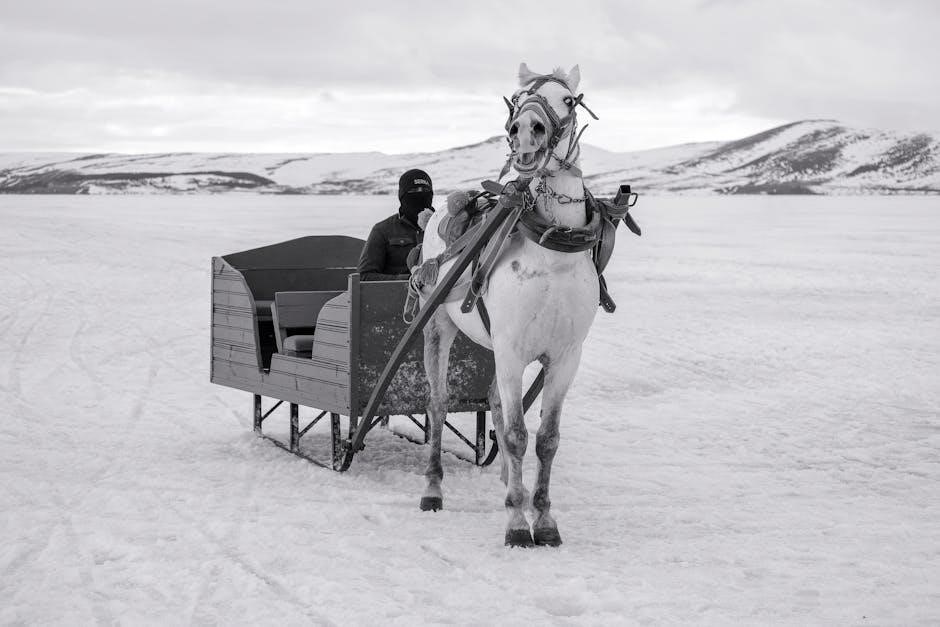
Common Mistakes to Avoid
Over- or under-blanketing is a frequent error, causing discomfort or health issues․ Ensure proper fit to prevent rubbing and restrict movement․ Avoid using damaged blankets, as they can harm your horse․ Ignoring seasonal temperature changes and failing to monitor your horse’s coat type are additional mistakes․ Regularly assess your horse’s needs to avoid these common pitfalls and keep your equine partner comfortable and thriving․
Special Considerations
Senior, clipped, or horses with health issues require tailored blanketing strategies․ Always consider their unique needs to ensure comfort and prevent complications, adapting as necessary․
Senior Horses
Senior horses often require extra care when it comes to blanketing․ Their ability to regulate body temperature may decline with age, making them more sensitive to cold․ Consider lighter-weight blankets for older horses, especially those with mobility issues, to prevent overheating․ Monitor their coat condition and overall health, as some seniors may need warmer blankets than younger horses․ Always ensure proper fit to avoid discomfort or restriction․
Clipped Horses
Clipped horses require special attention when it comes to blanketing․ Since their natural coat is reduced, they rely more on blankets for warmth, especially in cold weather․ Opt for lightweight to mid-weight blankets depending on the climate and your horse’s comfort․ Ensure proper fit to avoid rubbing or restricting movement․ Monitor their temperature closely, as clipped horses can be more prone to overheating indoors․ Adjust blanketing according to seasonal changes and their individual needs․
Horses with Health Issues
Horses with health issues, such as arthritis or circulatory problems, may need extra care when blanketing․ Blankets can help regulate their body temperature and provide comfort․ However, avoid overheating, as this can worsen certain conditions․ Choose breathable materials and monitor their response․ Always consult a veterinarian to determine the best blanketing strategy for horses with specific health needs, ensuring their comfort and well-being throughout the year․
Putting It All Together
By understanding your horse’s needs, selecting the right blanket, and monitoring weather conditions, you can create a effective blanketing strategy․ Always ensure proper fit, maintain cleanliness, and adjust based on your horse’s responses․ Regularly assess their comfort and health, especially for senior, clipped, or horses with medical conditions; With careful planning and attention, you can keep your horse warm, dry, and comfortable year-round, promoting their overall well-being and happiness․
Additional Resources
For further guidance, explore these trusted resources:
- SmartPak’s Horse Blanketing Guide offers detailed charts and expert advice․
- Equine Wellness Magazine provides articles on seasonal care and blanket maintenance․
- The Humane Society’s Horse Care Guide covers blanketing for senior and special-needs horses․
These resources ensure you’re well-informed to make the best decisions for your horse’s comfort and health․
